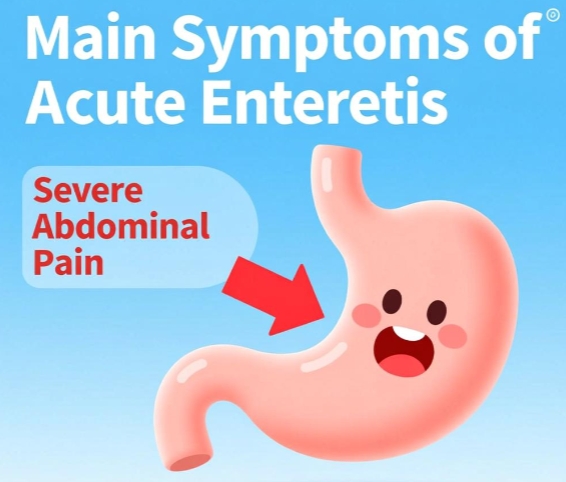Acute enteritis is a sudden inflammatory or infectious insult to the small-intestinal mucosa. It peaks within hours to a few days, usually resolves within one week, and ranges from mild cramps to rapidly dehydrating diarrhea. Recognising the characteristic features helps guide fluid replacement, diet choices, and the decision to seek medical care.
Red-flag combinations demanding urgent review
Persistent vomiting preventing oral intake, bloody diarrhea with orthostatic hypotension, continuous abdominal rigidity or localized rebound tenderness, fever >39 °C with altered consciousness, and oliguria despite attempted rehydration.
Core intestinal symptoms
Diarrhea: watery or loose, occasionally rice-water or blood-flecked; defined as ≥3 stools per day or >200 g per stool for <14 days.
Periumbilical cramps: colicky waves that build and recede, often relieved transiently by passing stool or flatus.
Hyperactive bowel sounds: audible gurgling or splashing without a stethoscope during active phases.
Bloating and distension: trapped gas plus mild ileus produces visible abdominal swelling.
Nausea and early satiety: more pronounced when the stomach is also involved (gastro-enteritis).
Systemic and dehydration clues
Low-grade fever 37.5–38.5 °C in viral or mild bacterial cases; >39 °C suggests invasive organisms.
Fatigue, myalgia, headache: part of systemic cytokine response.
Thirst, dry lips, coated tongue: early volume deficit.
Postural dizziness or syncope: ≥15 % circulating volume lost.
Sunken eyes, delayed skin turgor, hypotension: moderate to severe dehydration, especially when stool output exceeds eight episodes daily.
Pathogen-specific patterns
Viral (rotavirus, norovirus): vomiting often precedes diarrhea, fever mild, resolution in 3–5 days.
Pre-formed toxin (Bacillus cereus, Staph aureus): sudden cramps and watery stools 1–6 h after contaminated food, short total duration 12–24 h.
Invasive bacteria (Campylobacter, Salmonella, Shigella): fever >38.5 °C, stools may become bloody, fecal leukocytes visible.
Cholera-like: profuse painless “rice-water” stools, rapid dehydration, risk of hypovolemic shock within hours.
| Symptom cluster | Typical cause | Home-care threshold |
|---|---|---|
| Watery diarrhea, low fever | Viral | ORS 200 mL after each stool, solids when tolerated |
| Rice-water stools, no fever | Cholera | Seek care immediately; start ORS en route |
| Bloody stools, high fever | Invasive bacteria | Medical review for stool culture ± antibiotics |
| Vomiting every 30 min | Food-borne toxin | Small ice-chip sips; if >8 h no keep-down, visit ED |
| Sunken eyes, dizzy stand | Dehydration | If urine dark/scant or mental state changes, go to hospital |
